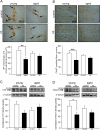Interactions between Aβ oligomers and presynaptic cholinergic signaling: age-dependent effects on attentional capacities
- PMID: 25101540
- PMCID: PMC4179990
- DOI: 10.1016/j.bbr.2014.07.046
Interactions between Aβ oligomers and presynaptic cholinergic signaling: age-dependent effects on attentional capacities
Abstract
Substantial evidence suggests that cerebral deposition of the neurotoxic fibrillar form of amyloid precursor protein, β-amyloid (Aβ), plays a critical role in the pathogenesis of Alzheimer's disease (AD). Yet, many aspects of AD pathology including the cognitive symptoms and selective vulnerability of cortically projecting basal forebrain (BF) cholinergic neurons are not well explained by this hypothesis. Specifically, it is not clear why cognitive decline appears early when the loss of BF cholinergic neurons and plaque deposition are manifested late in AD. Soluble oligomeric forms of Aβ are proposed to appear early in the pathology and to be better predictors of synaptic loss and cognitive deficits. The present study was designed to examine the impact of Aβ oligomers on attentional functions and presynaptic cholinergic transmission in young and aged rats. Chronic intracranial infusions of Aβ oligomers produced subtle decrements in the ability of rats to sustain attentional performance with time on task, irrespective of the age of the animals. However, Aβ oligomers produced robust detrimental effects on performance under conditions of enhanced attentional load in aged animals. In vivo electrochemical recordings show reduced depolarization-evoked cholinergic signals in Aβ-infused aged rats. Moreover, soluble Aβ disrupted the capacity of cholinergic synapses to clear exogenous choline from the extracellular space in both young and aged rats, reflecting impairments in the choline transport process that is critical for acetylcholine (ACh) synthesis and release. Although aging per se reduced the cross-sectional area of BF cholinergic neurons and presynaptic cholinergic proteins in the cortex, attentional performance and ACh release remained unaffected in aged rats infused with the control peptide. Taken together, these data suggest that soluble Aβ may marginally influence attentional functions at young ages primarily by interfering with the choline uptake processes. However, age-related weakening of the cholinergic system may synergistically interact with these disruptive presynaptic mechanisms to make this neurotransmitter system vulnerable to the toxic effects of oligomeric Aβ in robustly impeding attentional capacities.
Keywords: Aging; Alzheimer's disease; Attention; Cholinergic; Presynaptic; Soluble amyloid-beta.
Copyright © 2014 Elsevier B.V. All rights reserved.
Figures





Similar articles
-
Effects of sustained proNGF blockade on attentional capacities in aged rats with compromised cholinergic system.Neuroscience. 2014 Mar 7;261:118-32. doi: 10.1016/j.neuroscience.2013.12.042. Epub 2013 Dec 27. Neuroscience. 2014. PMID: 24374328 Free PMC article.
-
The basal forebrain cholinergic system in aging and dementia. Rescuing cholinergic neurons from neurotoxic amyloid-β42 with memantine.Behav Brain Res. 2011 Aug 10;221(2):594-603. doi: 10.1016/j.bbr.2010.05.033. Epub 2010 May 27. Behav Brain Res. 2011. PMID: 20553766
-
Developmental suppression of forebrain trkA receptors and attentional capacities in aging rats: A longitudinal study.Behav Brain Res. 2017 Sep 29;335:111-121. doi: 10.1016/j.bbr.2017.08.017. Epub 2017 Aug 10. Behav Brain Res. 2017. PMID: 28803853 Free PMC article.
-
The cholinergic system in aging and neuronal degeneration.Behav Brain Res. 2011 Aug 10;221(2):555-63. doi: 10.1016/j.bbr.2010.11.058. Epub 2010 Dec 9. Behav Brain Res. 2011. PMID: 21145918 Review.
-
Interactions between beta-amyloid and central cholinergic neurons: implications for Alzheimer's disease.J Psychiatry Neurosci. 2004 Nov;29(6):427-41. J Psychiatry Neurosci. 2004. PMID: 15644984 Free PMC article. Review.
Cited by
-
Whole-Brain Monosynaptic Afferent Inputs to Basal Forebrain Cholinergic System.Front Neuroanat. 2016 Oct 10;10:98. doi: 10.3389/fnana.2016.00098. eCollection 2016. Front Neuroanat. 2016. PMID: 27777554 Free PMC article.
-
Multi-target approach to Alzheimer's disease prevention and treatment: antioxidant, anti-inflammatory, and amyloid- modulating mechanisms.Neurogenetics. 2025 Apr 1;26(1):39. doi: 10.1007/s10048-025-00821-y. Neurogenetics. 2025. PMID: 40167826 Review.
-
Knowledge domains and emerging trends of Genome-wide association studies in Alzheimer's disease: A bibliometric analysis and visualization study from 2002 to 2022.PLoS One. 2024 Jan 19;19(1):e0295008. doi: 10.1371/journal.pone.0295008. eCollection 2024. PLoS One. 2024. PMID: 38241287 Free PMC article.
-
Moderate decline in select synaptic markers in the prefrontal cortex (BA9) of patients with Alzheimer's disease at various cognitive stages.Sci Rep. 2018 Jan 17;8(1):938. doi: 10.1038/s41598-018-19154-y. Sci Rep. 2018. PMID: 29343737 Free PMC article.
-
The influence of two functional genetic variants of GRK5 on tau phosphorylation and their association with Alzheimer's disease risk.Oncotarget. 2017 Aug 16;8(42):72714-72726. doi: 10.18632/oncotarget.20283. eCollection 2017 Sep 22. Oncotarget. 2017. PMID: 29069820 Free PMC article.
References
-
- Mesulam M. The cholinergic lesion of Alzheimer's disease: pivotal factor or side show? Learn Mem. 2004;11(1):43–9. - PubMed
-
- Dalley JW, Theobald DE, Bouger P, Chudasama Y, Cardinal RN, Robbins TW. Cortical cholinergic function and deficits in visual attentional performance in rats following 192 IgG-saporin-induced lesions of the medial prefrontal cortex. Cereb Cortex. 2004;14(8):922–32. - PubMed
-
- Everitt BJ, Robbins TW. Central cholinergic systems and cognition. Annual review of psychology. 1997;48:649–84. - PubMed
-
- Sarter M, Hasselmo ME, Bruno JP, Givens B. nraveling the attentional functions of cortical cholinergic inputs: interactions between signal-driven and cognitive modulation of signal detection. Brain research Brain research reviews. 2005;48(1):98–111. - PubMed
-
- Sarter M, Parikh V. Choline transporters, cholinergic transmission and cognition. Nature reviews Neuroscience. 2005;6(1):48–56. - PubMed
Publication types
MeSH terms
Substances
Grants and funding
LinkOut - more resources
Full Text Sources
Other Literature Sources
Medical
Miscellaneous

